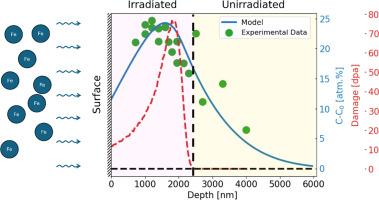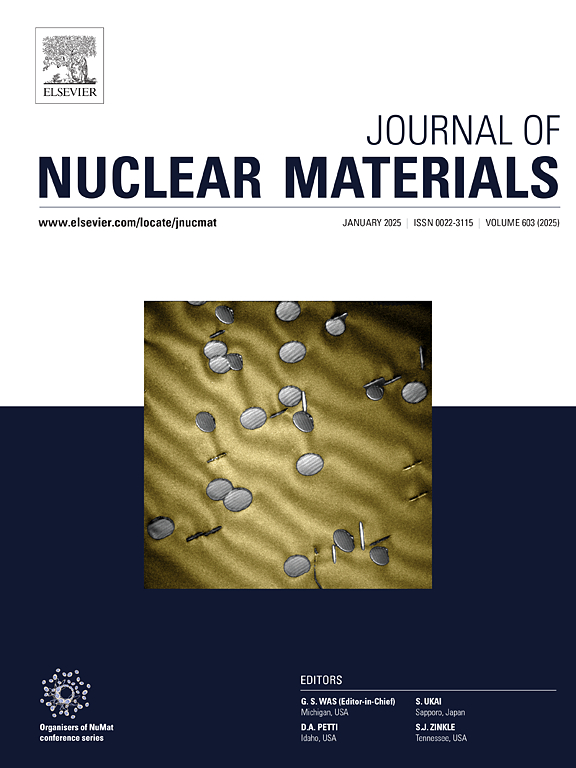离子辐照晶界处辐射诱导偏析的分析
IF 2.8
2区 工程技术
Q3 MATERIALS SCIENCE, MULTIDISCIPLINARY
引用次数: 0
摘要
在中子和带电粒子(质子和离子)辐照的合金中,辐射引起的偏析已经得到了广泛的研究。与中子和质子不同,重离子的穿透深度非常短(通常为几微米),因此,自由表面和末端区域可以显著影响辐射引起的微观结构变化。这些效应在空洞膨胀和位错环中得到了充分的证明;然而,对于晶界处辐射引起的偏析,它们的作用要小得多。为了解决这一问题,我们用铁离子辐照了一个Fe - ni - cr合金模型,并将晶界化学作为深度和剂量的函数进行了量化。讨论了表面氧化和晶界扩散对辐射偏析的影响。本文章由计算机程序翻译,如有差异,请以英文原文为准。

On the analysis of radiation-induced segregation at ion-irradiated grain boundaries
Radiation-induced segregation has been extensively studied in alloys irradiated with neutrons and charged particles (protons and ions). Unlike neutrons and protons, heavy ions have a very short penetration depth (typically a few micrometers), and for this reason, the free surface and end-of-range region can significantly affect radiation-induced microstructural changes. These effects are well-documented for void swelling and dislocation loops; however, they are much less so for radiation-induced segregation at grain boundaries. To address this gap, a model Fe–Ni–Cr alloy was irradiated using Fe ions and grain boundary chemistry was quantified as a function of depth and dose. The impacts of surface oxidation and grain boundary diffusion on radiation-induced segregation are discussed.
求助全文
通过发布文献求助,成功后即可免费获取论文全文。
去求助
来源期刊

Journal of Nuclear Materials
工程技术-材料科学:综合
CiteScore
5.70
自引率
25.80%
发文量
601
审稿时长
63 days
期刊介绍:
The Journal of Nuclear Materials publishes high quality papers in materials research for nuclear applications, primarily fission reactors, fusion reactors, and similar environments including radiation areas of charged particle accelerators. Both original research and critical review papers covering experimental, theoretical, and computational aspects of either fundamental or applied nature are welcome.
The breadth of the field is such that a wide range of processes and properties in the field of materials science and engineering is of interest to the readership, spanning atom-scale processes, microstructures, thermodynamics, mechanical properties, physical properties, and corrosion, for example.
Topics covered by JNM
Fission reactor materials, including fuels, cladding, core structures, pressure vessels, coolant interactions with materials, moderator and control components, fission product behavior.
Materials aspects of the entire fuel cycle.
Materials aspects of the actinides and their compounds.
Performance of nuclear waste materials; materials aspects of the immobilization of wastes.
Fusion reactor materials, including first walls, blankets, insulators and magnets.
Neutron and charged particle radiation effects in materials, including defects, transmutations, microstructures, phase changes and macroscopic properties.
Interaction of plasmas, ion beams, electron beams and electromagnetic radiation with materials relevant to nuclear systems.
 求助内容:
求助内容: 应助结果提醒方式:
应助结果提醒方式:


